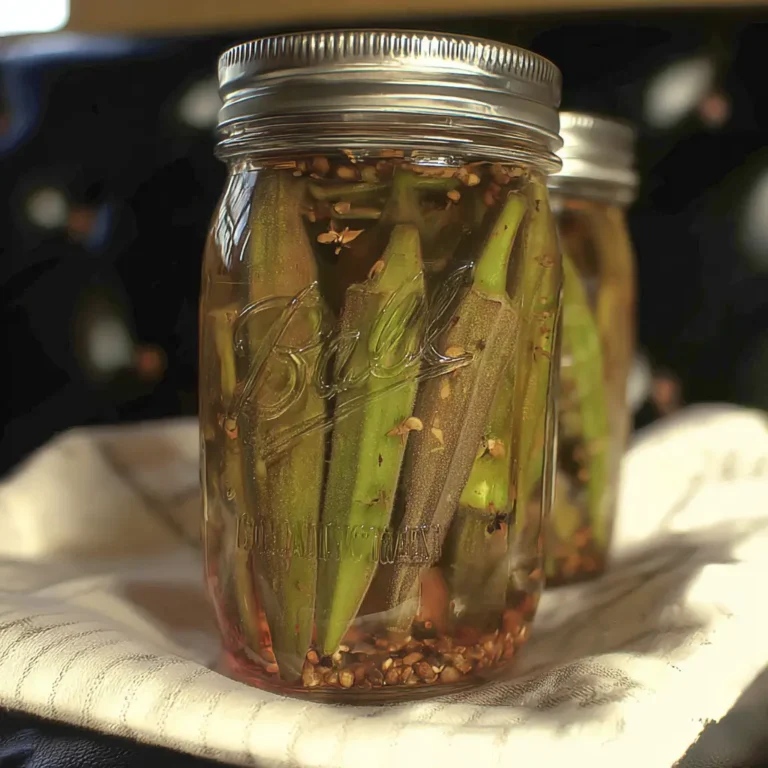Transform humble fresh okra into a tangy, probiotic-rich delicacy that Southern grandmothers have perfected for generations. Many people struggle with the slimy texture of cooked okra and don’t know how to preserve their seasonal abundance, but pickled okra offers the perfect solution. This comprehensive guide will help you master the art of pickled okra with foolproof techniques, nutritional benefits, and creative serving ideas that will make this Southern staple a year-round favorite in your kitchen.
Whether you’re dealing with an overflowing garden harvest or simply want to explore traditional preservation methods, learning to pickle okra opens up a world of culinary possibilities. The pickling process not only eliminates the texture concerns many have with fresh okra but also creates a versatile ingredient that enhances countless dishes while providing exceptional nutritional value.
Table of Contents
What Makes Pickled Okra Unique: Benefits and Varieties
Nutritional Benefits of PickledOkra
Pickled okra retains most of the nutritional benefits of fresh okra while adding probiotic advantages from the fermentation process. According to the USDA nutrition database, okra provides significant amounts of vitamin C, vitamin K, and folate. The pickling process preserves these nutrients while introducing beneficial bacteria that support digestive health.
Each serving of okra contains approximately 4 grams of fiber, which aids digestion and helps maintain stable blood sugar levels. The fermentation process also creates probiotics that support gut health, making pickled okra not just delicious but genuinely beneficial for your overall wellness. Additionally, the low calorie content (only 25 calories per cup) makes it an excellent choice for health-conscious individuals.
Best Okra Varieties for Pickling
Selecting the right okra variety significantly impacts your pickled okra results. Clemson Spineless remains the gold standard for pickling due to its tender texture and consistent size. Emerald Green Velvet offers exceptional color retention and crisp texture after pickling, while Annie Oakley II provides uniform pods perfect for jar packing.
For optimal results, choose okra pods that are 2-4 inches long and bright green with no brown spots. Young, tender pods pickle best because they maintain their crunch without becoming tough or woody. Harvest okra in the morning when pods are crisp and full of moisture for the best okra texture.
Pickled vs Fresh Okra Comparison
| Aspect | Fresh Okra | Pickled Okra |
|---|---|---|
| Texture | Can be slimy when cooked | Crisp and firm |
| Shelf Life | 3-5 days refrigerated | 12+ months when properly canned |
| Nutritional Value | High vitamins and minerals | Retained nutrients plus probiotics |
| Versatility | Requires cooking preparation | Ready-to-eat, multiple uses |
Essential Pickled Okra Recipe: Step-by-Step Guide
Ingredients and Equipment Needed
Creating perfect pickled okra requires specific ingredients and proper equipment. Gather 2 pounds of fresh small okra pods, 4 cups white vinegar (5% acidity), 4 cups water, 1/4 cup kosher salt, 8 garlic cloves, 4 fresh dill sprigs, 2 tablespoons whole peppercorns, and 1 tablespoon mustard seeds.
Essential equipment includes four pint-sized canning jars with new lids, a large non-reactive pot for the brine, a water bath canner or large stockpot, and a jar lifter for safety. Always follow USDA canning safety guidelines when pressure canning to ensure food safety and prevent botulism.
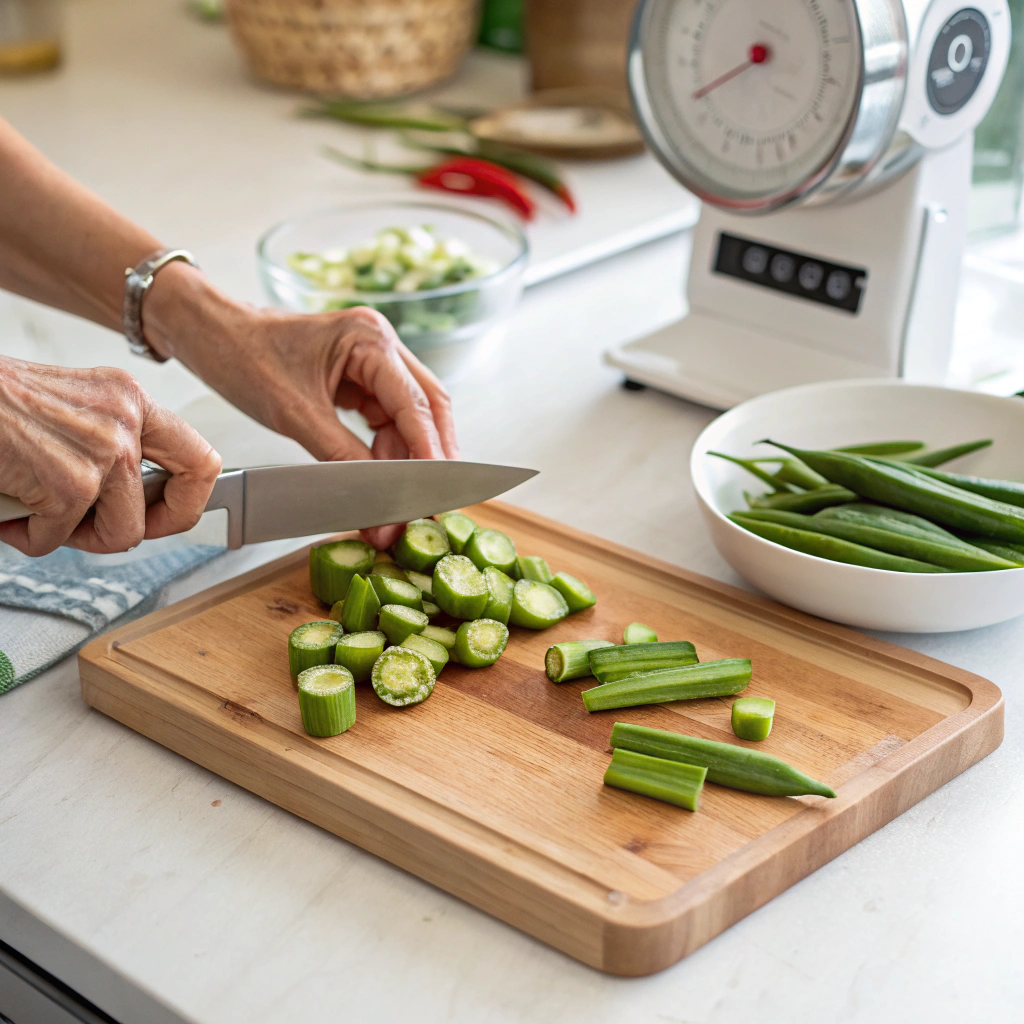
Preparation and Sterilization Process
Begin by washing okra pods thoroughly and trimming stems, leaving about 1/4 inch to prevent the pods from opening during pickling. Sterilize jars and lids by boiling for 10 minutes, then keep warm until ready to fill. This sterilization step is crucial for achieving shelf-stable pickled okra.
While jars sterilize, prepare your workspace with clean towels and organize ingredients for efficient assembly. The key to professional-quality okra lies in maintaining cleanliness throughout the process and working quickly once the hot brine is ready.
Brining and Seasoning Techniques
Combine vinegar, water, and salt in your large pot, bringing the mixture to a rolling boil. This brine provides the acidic environment necessary for safe pickling while creating the characteristic tangy flavor that makes pickled okra irresistible.
Pack okra vertically in sterilized jars, adding 2 garlic cloves, 1 dill sprig, 1/2 tablespoon peppercorns, and 3/4 teaspoon mustard seeds to each jar. The vertical packing method ensures maximum jar capacity while maintaining attractive presentation.
Canning and Sealing Methods
Pour hot brine over okra, leaving 1/2 inch headspace at the top of each jar. Remove air bubbles by gently tapping jars and running a plastic knife around the edges. Wipe jar rims clean, apply lids, and process in a boiling water bath for 10 minutes.
Allow jars to cool completely before checking seals. Properly sealed jars will have concave lids that don’t flex when pressed. Store sealed jars in a cool, dark place and allow pickled okra to develop full flavor for at least 2 weeks before consuming.
Advanced Pickled Okra Techniques and Variations
Quick Pickle vs Traditional Canning
Quick pickled okra offers immediate gratification for those wanting faster results. Simply pack okra in jars, pour hot brine over pods, and refrigerate for 24 hours. This method produces crisp, flavorful okra that lasts up to 2 months refrigerated but isn’t shelf-stable.
Traditional canning creates shelf-stable pickled okra lasting 12-18 months. The heat processing slightly softens texture but develops deeper, more complex flavors over time. Choose your method based on intended storage and consumption timeline.
International Flavor Profiles
Mediterranean-style pickled okra incorporates oregano, bay leaves, and lemon zest for a bright, herbaceous flavor. Indian-inspired versions feature turmeric, coriander seeds, and dried chilies, creating golden-colored okra with warming spices.
Korean-influenced pickled okra uses rice vinegar, ginger, and red pepper flakes for a sweet-heat combination that pairs beautifully with grilled meats and grain bowls. Experiment with different spice combinations to create signature pickled okra varieties.
Spice Blends and Seasonings
Classic Southern pickled okra relies on dill, garlic, and peppercorns, but countless variations exist. Try adding whole allspice berries, cardamom pods, or fennel seeds for unique flavor profiles. Dried herbs like thyme, rosemary, or oregano add Mediterranean flair.
For heat lovers, incorporate jalapeño slices, crushed red pepper, or whole dried chilies. Sweet variations benefit from adding whole cloves, cinnamon sticks, or star anise for warming, aromatic notes that complement okra’s natural earthiness.
Fermentation Methods
Lacto-fermented pickled okra uses salt brine instead of vinegar, creating naturally probiotic preserves through beneficial bacterial fermentation. This traditional method produces tangy, complex flavors while maximizing health benefits through live cultures.
The fermentation process typically takes 3-7 days at room temperature, followed by refrigeration to slow fermentation. Fermented pickled okra has a more complex, less acidic flavor than vinegar-pickled versions and provides maximum probiotic benefits.
Troubleshooting Common Pickled Okra Problems
Preventing Mushy Texture
Mushy okra typically results from overcooking during processing or using overripe pods. Select young, firm okra and limit processing time to exactly 10 minutes in the boiling water bath. Adding calcium chloride (available at brewing supply stores) helps maintain crispness.
Ice water baths immediately after harvesting help preserve cell structure, resulting in crispier pickled okra. Never use okra that feels soft or shows signs of age, as these will never achieve the desired crisp texture regardless of technique.
Fixing Cloudy Brine Issues
Cloudy brine usually indicates bacterial activity but isn’t always dangerous. Natural fermentation can cause cloudiness in properly acidified pickles. However, if cloudiness appears with off-odors or mushy texture, discard the product immediately.
Prevent cloudiness by using distilled water instead of tap water, which may contain minerals that react with brine components. Additionally, ensure proper acid levels and processing times according to established University of Minnesota Extension pickling guide recommendations.
Adjusting Salt and Acid Levels
Proper acid levels ensure safety in pickled okra, while salt affects flavor and preservation. Never reduce vinegar below recipe requirements, as this compromises safety. If pickles taste too salty, dilute brine slightly with additional vinegar rather than water.
Test brine pH using digital meters or pH strips, aiming for 3.5 or lower for safe okra. Insufficient acid creates dangerous conditions for botulism growth, while proper acidification ensures both safety and optimal flavor development.
Storage Problems and Solutions
Proper storage prevents common pickled okra problems. Store sealed jars in cool, dark locations with stable temperatures between 60-70°F. Temperature fluctuations can cause seal failure and spoilage.
Once opened, refrigerate pickled okra and consume within 2 months for best quality. Always use clean utensils when removing okra from jars to prevent introducing bacteria that could cause spoilage.
Storage and Serving Ideas for Pickled Okra
Proper Storage Methods and Shelf Life
Properly processed okra maintains peak quality for 12-18 months when stored in cool, dark conditions. Label jars with processing dates and rotate stock using oldest jars first. Inspect jars periodically for signs of seal failure or spoilage.
Refrigerated quick pickles maintain quality for 2-3 months, while opened canned pickled okra should be consumed within 2 months for optimal texture and flavor. Always refrigerate after opening and keep okra submerged in brine to prevent deterioration.
Creative Serving Suggestions
Pickled okra shines as a standalone appetizer or incorporated into various dishes. Serve alongside cheese and crackers for elegant entertaining, or chop into potato salad for Southern flair. The tangy crunch adds excellent contrast to rich, creamy dishes.
Thread whole okra onto skewers with cherry tomatoes and fresh mozzarella for colorful appetizer presentations. The pods also make excellent additions to vegetable platters, providing unique flavor and visual interest that guests remember.
Pairing with Other Foods
Pickled okra complements grilled meats beautifully, cutting through richness with acidic brightness. Pair with barbecued chicken, grilled fish, or vegetarian protein alternatives for balanced flavor profiles. The tangy bite enhances smoky, savory flavors perfectly.
Consider serving pickled okra alongside a Cajun-inspired dipping sauce for added Southern flair, or incorporate into a hearty Southern bean dish for traditional comfort food combinations.
Using Pickled Okra in Recipes
Beyond serving whole, pickled okra adds tang to numerous recipes. Chop into relishes, fold into grain salads, or blend into vinaigrettes for salad dressings. The pickled flavor enhances both hot and cold preparations.
Try adding chopped okra to cornbread batter, mixing into chicken salad, or garnishing soups for acidic brightness. It pairs exceptionally well with seafood preparations like a classic Southern seafood boil, where the tangy crunch complements sweet, tender shellfish.
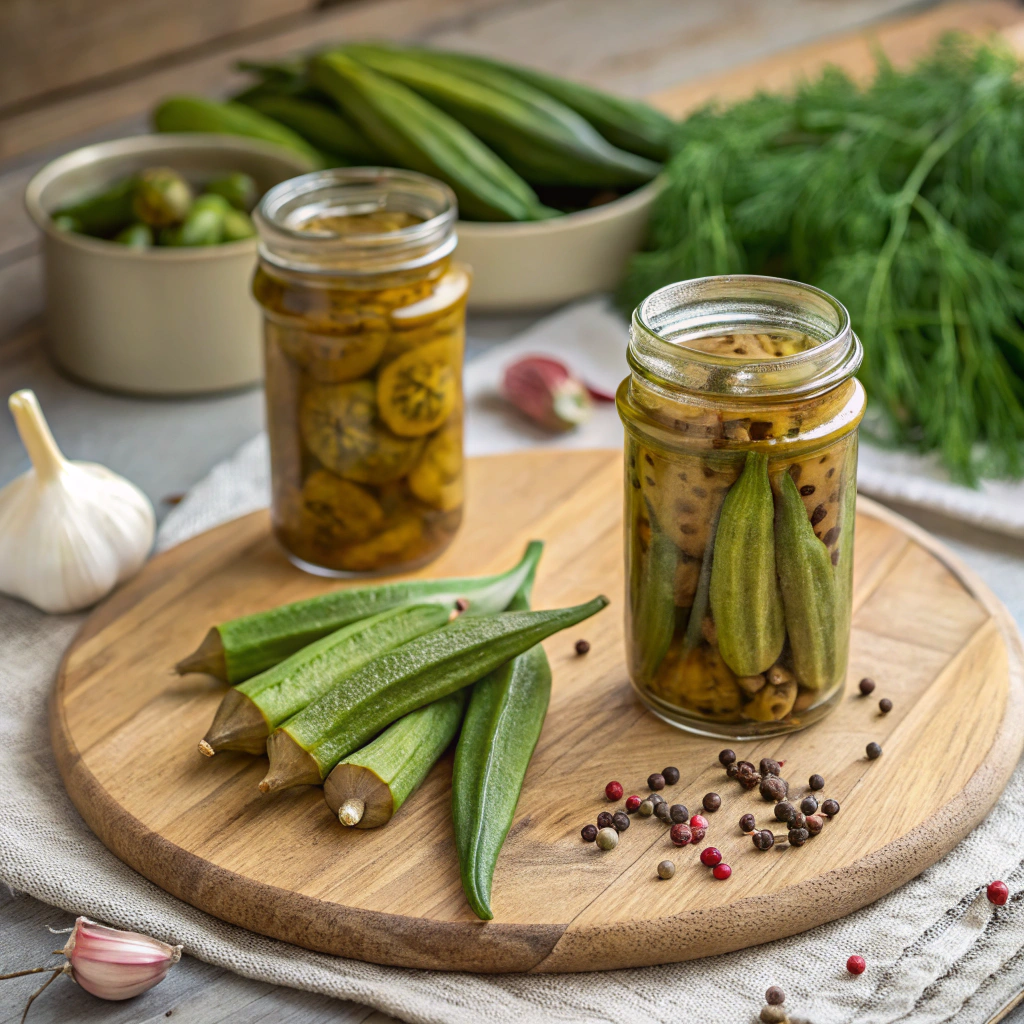
Frequently Asked Questions About Pickled Okra
How long does homemade pickled okra last in the refrigerator?
Homemade pickled okra lasts 2-3 months in the refrigerator when properly stored in clean, airtight containers. Quick-pickled versions maintain best quality for 6-8 weeks, while traditionally canned okra, once opened, should be consumed within 2 months. Always keep okra submerged in brine and use clean utensils to prevent contamination. Signs of spoilage include cloudy brine with off-odors, mushy texture, or visible mold growth.
Can you pickle okra without a pressure canner?
Yes, you can safely pickle okra using a simple water bath canning method since the high acidity from vinegar creates a safe environment. Pressure canning isn’t necessary for acidified pickled okra recipes that follow tested guidelines. You can also make refrigerator pickles that don’t require any special canning equipment – just pack okra in jars, add hot brine, and refrigerate for shelf life of 2-3 months.
What makes okra slimy and how do you prevent it?
Sliminess in pickled okra typically results from using overripe pods or overcooking during processing. Okra contains mucilage, a natural substance that becomes more prominent with heat and age. Prevent slimy pickled okra by selecting young, firm pods under 4 inches, limiting processing time to exactly 10 minutes, and adding calcium chloride to maintain cell structure. Quick pickling methods often produce crisper results than traditional canning.
Is pickled okra good for digestive health?
Pickled okra offers excellent digestive health benefits through its combination of probiotics from fermentation and high fiber content. Each serving provides approximately 4 grams of fiber, supporting healthy digestion and stable blood sugar levels. Fermented okra contains beneficial bacteria that support gut microbiome health, while the natural compounds in okra may help reduce inflammation and support overall digestive wellness.
Can you reuse pickled okra brine for other vegetables?
While flavorful, used pickled okra brine shouldn’t be reused for canning other vegetables due to reduced acidity and potential contamination. However, you can safely use leftover brine for quick refrigerator pickles with cucumbers, carrots, or onions that will be consumed within a few weeks. The brine also makes an excellent addition to salad dressings, marinades, or as a tangy cooking liquid for grains.
What size okra pods work best for pickling?
The ideal size for pickled okra is 2-4 inches long, harvested when pods are young and tender. Smaller pods (2-3 inches) offer the most tender texture and best jar packing efficiency, while larger pods may develop tough, woody textures. Choose bright green pods without brown spots or signs of maturity. Uniformly sized pods ensure even processing and attractive presentation in finished jars.
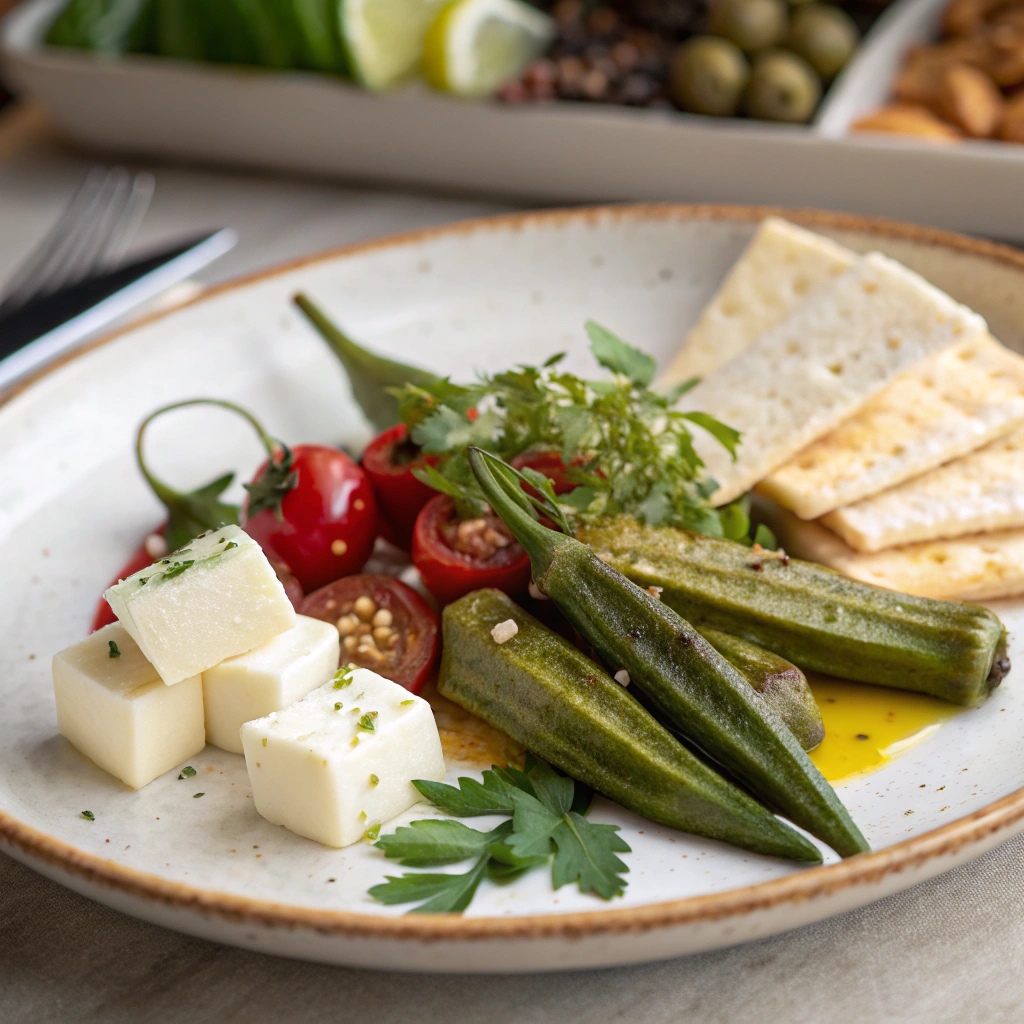
Mastering pickled okra transforms a sometimes challenging vegetable into a versatile, delicious preserve that enhances countless meals throughout the year. The techniques outlined in this guide accommodate different skill levels and preferences, from quick refrigerator pickles to traditionally canned varieties that last months in storage. Whether you choose classic Southern seasonings or experiment with international flavor profiles, pickled okra provides exceptional nutritional benefits while solving the texture concerns many have with fresh okra. With proper storage methods and creative serving ideas, your homemade pickled okra will become a pantry staple that adds tangy crunch and probiotic benefits to everything from simple snacks to elaborate entertaining spreads.
Print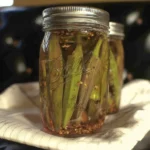
Old-Fashioned Pickled Okra
- Total Time: 55 minutes (plus 4-6 weeks curing)
- Yield: 18 servings (3 pint jars) 1x
- Diet: Vegan
Description
Capture the essence of Southern tradition with this time-honored pickled okra recipe that transforms humble garden okra into tangy, crunchy perfection! These gorgeous jars of pickled okra are packed with garlic, dill, and just the right amount of heat from black peppercorns. Perfect for snacking, adding to bloody marys, or bringing to potlucks where they’ll disappear faster than you can say ‘y’all come back!’ The secret is in the patience—let them cure for 4-6 weeks for that perfect pickle flavor that’ll make your taste buds sing.
Ingredients
- 2½ pounds fresh okra (choose small, tender pods)
- 3 cloves garlic, peeled
- 3 teaspoons canning salt
- 3 teaspoons dill seed
- ¾ teaspoon whole black peppercorns
- 2 cups white vinegar (5% acidity)
- 2 cups water
Equipment Needed:
- 3 pint-sized canning jars with lids and rings
- Large pot for water bath canning
- Canning rack or towel
Instructions
- Prepare Your Canning Setup: Sterilize jars, rings, and lids according to standard canning procedures. Wash in hot, soapy water, then submerge in boiling water for a few minutes. Keep everything hot until ready to use.
- Pack Like a Pro: Into each sterile pint jar, pack as many okra pods as possible with tips pointing up, creating a beautiful arrangement. Work efficiently while jars are still hot.
- Add the Flavor Arsenal: To each jar, add 1 whole garlic clove, 1 teaspoon canning salt, 1 teaspoon dill seed, and ¼ teaspoon whole black peppercorns. These aromatics will infuse every pod with incredible flavor!
- Maximize the Pack: Continue packing jars with additional okra, this time tips pointing down, fitting pods tightly without crushing them. The tighter the pack, the crunchier your pickles will be.
- Create the Perfect Brine: In a medium saucepan, bring vinegar and water to a rolling boil. Immediately pour the hot brine into jars, leaving ¼ inch headspace at the top.
- Seal and Process: Place lids and rings on jars, finger-tight only. Process in a boiling water bath: 10 minutes (up to 1,000 ft altitude), 15 minutes (1,001-6,000 ft), or 20 minutes (over 6,000 ft).
- Cool and Wait for Magic: Remove jars and let cool completely on a towel. You’ll hear the satisfying ‘pop’ of successful sealing! Store in a cool, dark place for 4-6 weeks for the best flavor development.
Notes
This recipe makes 3 perfect pint jars and doubles or triples beautifully for larger batches! When prepping okra, only trim tops if absolutely necessary—cutting into the pod body can make them mushy. Choose the smallest, most tender pods for the crunchiest results. Any jars that don’t seal properly should be refrigerated and enjoyed first. The waiting period is crucial—those 4-6 weeks allow the flavors to meld into pickle perfection that’s worth every day of anticipation!
- Prep Time: 45 minutes
- Cook Time: 10 minutes
- Category: Canning and Preserving
- Method: Water Bath Canning
- Cuisine: Southern American
Nutrition
- Serving Size: 1 serving (about 3-4 okra pods)
- Calories: 24
- Sugar: 1g
- Sodium: 324mg
- Fat: 1g
- Saturated Fat: 1g
- Unsaturated Fat: 0g
- Trans Fat: 0g
- Carbohydrates: 5g
- Fiber: 2g
- Protein: 1g
- Cholesterol: 0mg
Keywords: pickled okra, southern pickles, canning recipe, preserved vegetables

